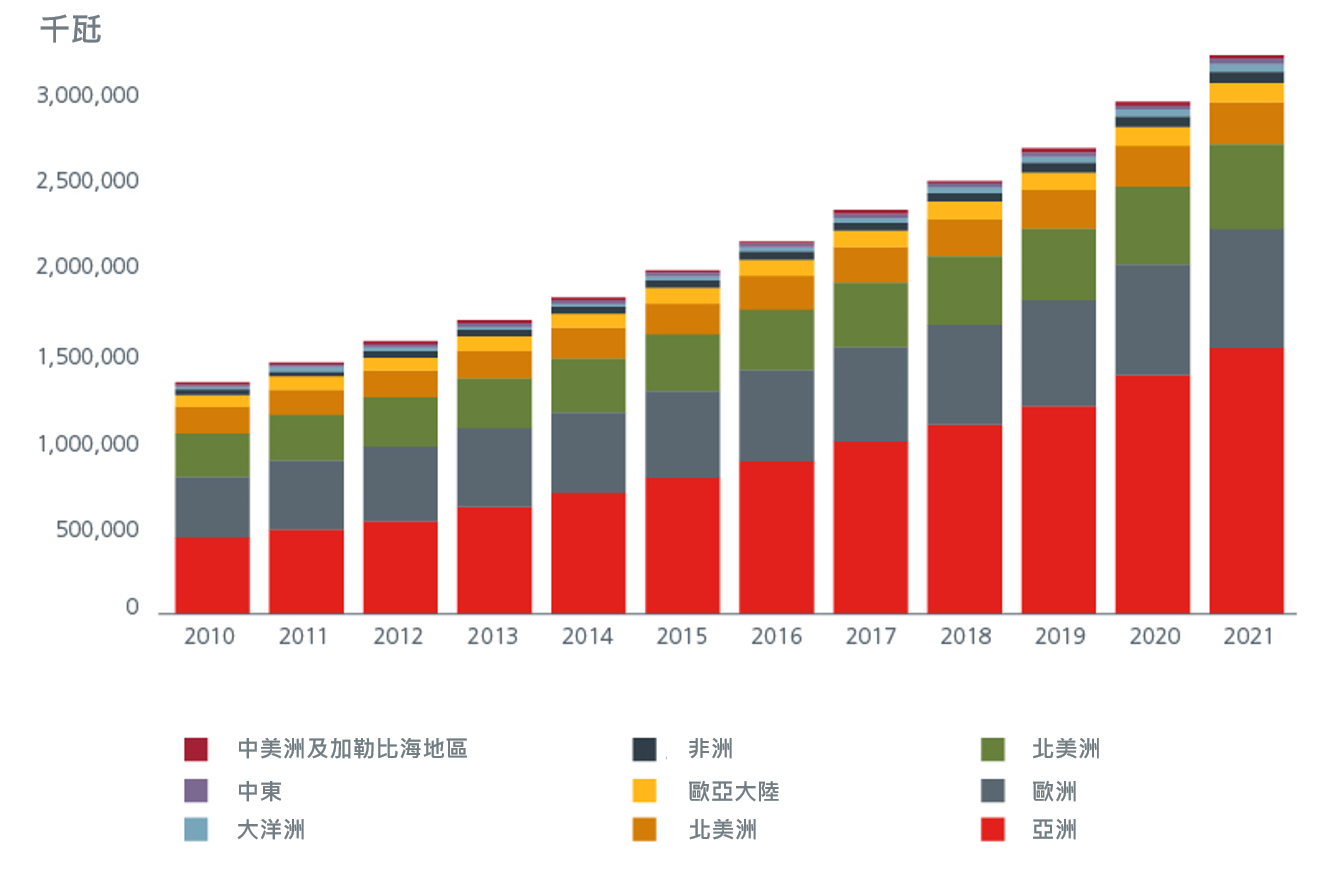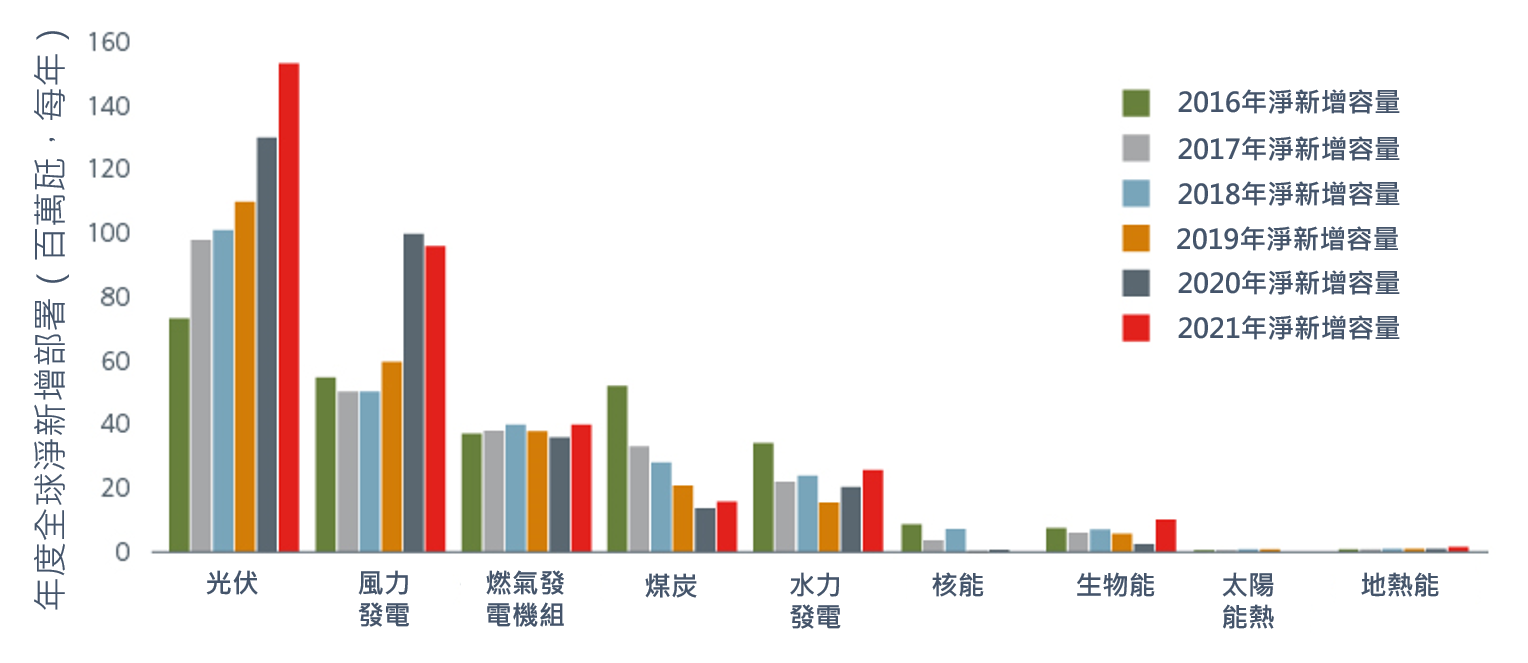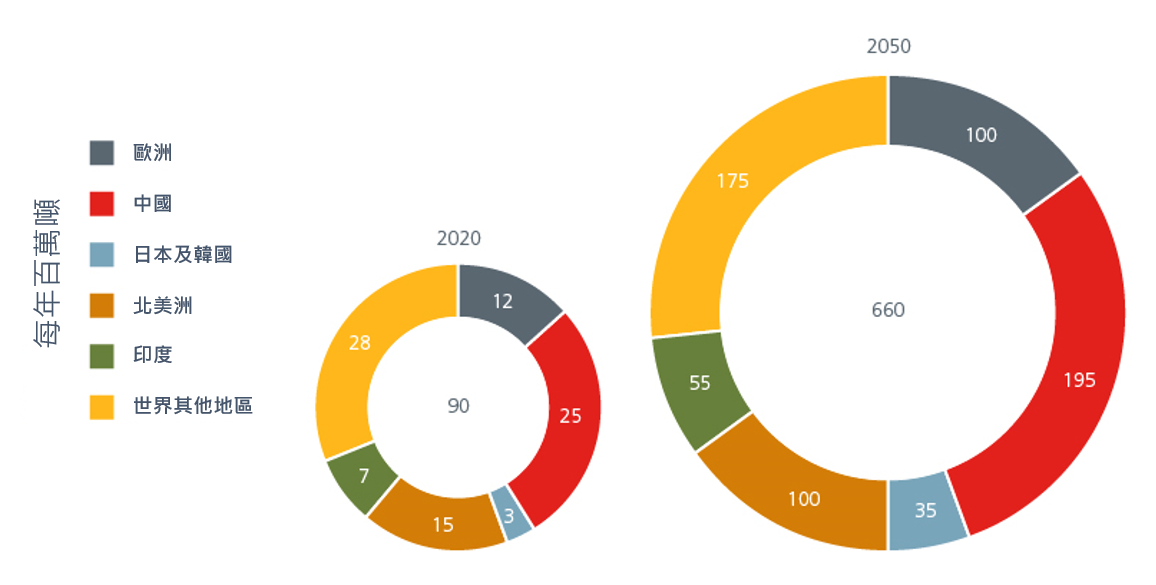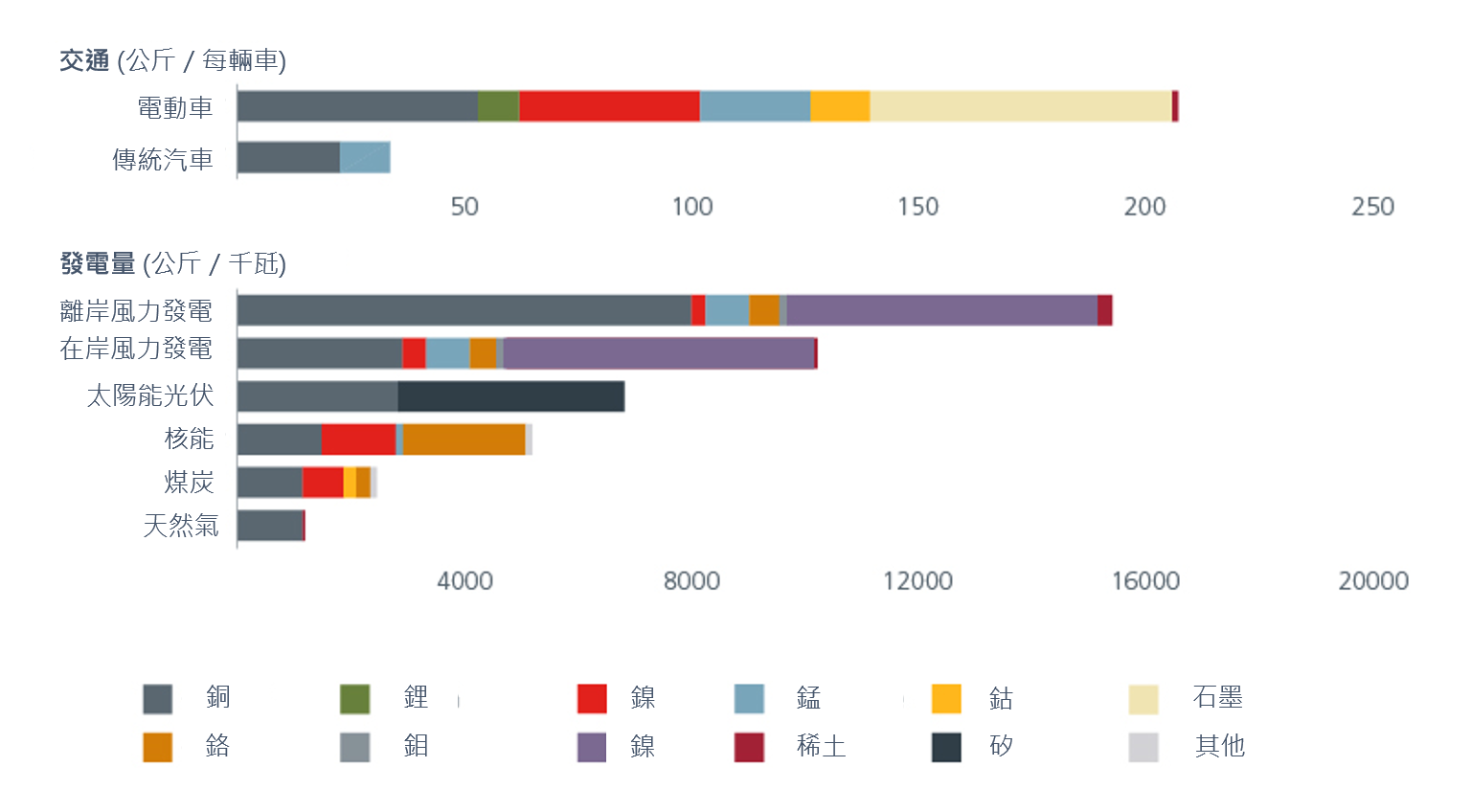亞洲擁有全球最豐富及多元的天然資源1,多種資源推動亞洲數十年來快速成長。亞洲國家是全球農業、漁業、林業及採礦業產品的主要生產國。然而,這種成長卻以犧牲環境作為代價。隨著氣候變化成為亞洲未來成長的最大威脅,亞洲各國政府日益將永續發展納入經濟計畫。
由於亞洲大部分碳排放來自能源及交通產業,許多永續發展項目均以潔淨能源轉型及綠色交通為重點。我們認為,隨著亞洲致力加速減碳,該區蘊含了龐大的永續成長機會。
在亞洲投資理據一文中,我們強調永續發展是亞洲未來主要成長動力之一。永續發展由「綠化」資源開始。此舉將對亞洲的資源產業造成最大影響,因為其往往是所有全球價值鏈的起點。有鑒於此,亞洲正積極發展綠色能源,即再生能源及氫能。
再生能源崛起
再生能源是衍生自大自然的綠色能源,即太陽能、風力發電、水力發電、地熱能及生物質能。亞洲約佔全球再生能源發電量的45%,其中,中國、印度及澳洲佔一半比率。見圖1。東協方面,超過80%再生能源容量分佈於越南、泰國、菲律賓、馬來西亞及印尼。2
圖1:按地區劃分的再生能源容量

資料來源:國際再生能源總署,2022年7月。
近年,全球淨新增發電容量的四分之三來自太陽能及風力發電機。3見圖2。大部分國家在太陽能及/或風力發電資源方面均實現自給自足;多個亞洲國家能夠以較低的環境成本全年不斷收集太陽輻射。再生能源的關鍵優勢是在爆發戰爭或貿易戰時沒有供應受阻的風險。
圖2:2016年至2021年全球淨新增發電容量

資料來源︰國際可再生能源總署、潔淨能源監管局、全球風能協會、世界核能協會、全球能源大會、國際光伏技術路線圖、國際能源署,2021年。
預計到2035年,亞洲整體電力結構的再生能源容量將由2022年的40%持續增加至63%。亞洲各國擬定的再生能源路徑圖均非常積極。例如,在大型水力發電及太陽能技術的支持下,馬來西亞的全國性再生能源目標是到2025年佔電力結構的31%。中國在第十四個五年規劃提出到2025年實現33%電力來自再生能源的目標。同時,印度的目標是到2030年有50%電力來自再生能源。
各國設下這些目標,帶來了廣泛的投資機會,涵蓋再生能源發電商以及太陽能及風力發電機組與電池製造商,以至開採用於電池及太陽能電池板的鎳及鋰等礦物的公司。
氫氣可能帶來重大改變
氫能是在亞洲引起極大興趣的另一種能源。氫氣能夠以天然氣、煤炭、生質能,甚至太陽能及風力等再生能源生產。氫氣的其中一個主要好處是其長期儲存能量的潛力。因此,氫氣可以在有需要時即時使用。氫氣亦易於液化及運送。此外,由於重量輕,氫氣是飛機燃料的理想替代品。
氫能開始在多個國家的長期能源戰略中佔據顯著位置。日本、韓國及印度等亞洲國家甚至制定了國家氫能戰略;日本是最早在2017年採用「氫能基本戰略」的國家之一。到2050年,氫能將成為全球能源市場的重要部分。見圖3。中國、印度、日本、韓國、歐洲及北美洲將佔全球氫氣需求的75%。4
圖3:按地區劃分的氫氣需求,每年百萬噸

資料來源:氫能委員會及麥肯錫公司,2022年10月。
目前,大部分氫氣以煤及天然氣等化石燃料生產,由於在生產過程仍然會排放碳,這類氫氣被稱為「灰氫」。為了實現淨零排放目標,各國正在將重點轉移至「綠氫」——最潔淨的氫氣之上。綠氫透過以再生能源發電的電解過程形成。
亞洲正迅速成為綠氫的生產基地。中國正在新疆建設全球最大的太陽能綠氫工廠。5同樣地,印度憑藉廉價太陽能成為綠氫成本的領先國家,而韓國的目標則是在30年內將潔淨氫氣的比例提高至50%,在50年內提高至100%。
隨著邁向氫能的能源轉型步伐加快,整個價值鏈亦將出現投資機會。生產綠氫所需的電解槽的製造商以及提供儲存設施及開發輸氫管道的公司均會獲得市場青睞。
原物料帶動綠色科技發展
隨著各國過渡至潔淨能源,對原物料的需求必將上升;銅、鋅、矽及鎳是部分應用於綠色能源科技的關鍵礦物。鋰、鎳、鈷、錳及石墨對電池性能相當重要。風力發電機組的永磁需要使用稀土金屬生產。銅及鋁是電網的關鍵金屬。
幸運的是,亞洲擁有豐富的相關原物料。例如,印尼及菲律賓擁有龐大的鎳存量,而中國則擁有銅、石墨、鋰及稀土。亞洲亦遍佈鋁土礦、錫及稀土金屬等其他原材料。投資於亞洲採礦公司或許是把握此機會的途徑之一。
圖4:個別綠色能源科技使用的礦物

資料來源︰國際能源署,2022年3月。
由於交通運輸業是亞洲最大碳排放產業之一,轉型至電動車的趨勢在亞洲淨零排放發展過程中發揮重要作用。到2025年,亞洲所有汽車中將有20%為電動車。6目前,中國是全球最大的電動車生產國。同時,泰國、印尼及越南亦在推動國內電動車市場的發展。電動車的投資機會延伸至汽車製造商以外的電池製造商,電池是電動車的關鍵零件。隨著對電動車及電池的需求增加,對生產電動車所需的關鍵礦物的需求亦隨之增加。
對替代食品的需求不斷增加
除了亞洲轉型至綠色能源帶來的投資機會以外,食品業亦是值得一提以及即將崛起的產業。到2030年,全球將有近半人口在亞洲居住。因此,確保亞洲的糧食安全至關重要。食品的穩健性現已納入多個國家旨在實現自給自足的計畫。此外,由於亞洲的農業對氣候變化舉足輕重,改善耕種方式及推動創新替代食品將促進亞洲的永續發展計畫。
市場對於科技食品解決方案的興趣越來越大,尤其是替代蛋白質產品。對植物肉產業的需求正在上升;彭博產業研究表現,亞太區有可能主導全球植物蛋白市場,到2030年,該市場的價值將由2020年的135億美元上升至648億美元。 好消息是多個亞洲國家亦能夠供應製造植物蛋白產品所需的原物料(綠豆、大豆等)。
農糧廢物是另一個值得注意的領域,因為其是生產生物燃料及增值化學品的潛在資源;印尼生產棕櫚油產生的液體廢物可轉化成沼氣,香蕉殘渣的纖維正用於製作時尚產品。採用綠色科技解決方案以提高收成及減少廚餘的農業公司有望取得理想表現。
循環經濟是永續發展的關鍵
推動循環經濟對於真正實現整個亞洲的永續發展亦非常重要。循環經濟旨在減少、重複利用及回收物料。透過重複利用物料,循環經濟可以將廢物轉化為資源,釋放大量新商機,創造多個全新就業機會,涵蓋回收與維修以至數位及創新工作。
若干亞洲國家已採取了專門的循環經濟政策。然而,要實現區域循環經濟,亞洲需要制定正式標準。好消息是,東協於2021年10月採用了循環經濟框架,該框架識別出五個策略重點;其中一個重點是有效利用能源及其他資源。儘管如此,亞洲需要更加統一及全面的政策,以帶來實際的經濟及環境效益。